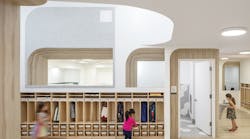Three new US government reports shed a broad light on the transition to LED-based solid state lighting (SSL) covering lighting performance, environmental impact, and the pace and state of the transition to SSL. The US Department of Energy (DOE) issued a Caliper on the performance of LED and fluorescent ceiling troffers, and the "LED Environmental Testing" report that focuses on whether toxic elements are present in LED lighting. The National Academy of Sciences (NAS), meanwhile, issued a report entitled "Assessment of Advanced Solid Sate Lighting" that examines the lighting transition and the DOE's role in advancing SSL.
The new environmental report is the third and final part of a comprehensive DOE research project focused on the environment impact of LED technology, relative to legacy sources, over the course of the complete lifecycle of a lighting product. The first of the three reports was issued in February 2012 and focused on energy consumption associated with LED lamps including the energy needed to manufacturer, operate and dispose of the products. The second part focused on the direct and indirect, material and process impacts.
The final part of the project details the disassembly and testing of 22 lamps for 17 potentially-toxic elements that could exceed governmental guidelines for hazardous waste. The testing included grinding the lamps to expose encapsulated materials. All of the reports are available on the DOE website.
Results from the final report reveal that the destructed LED lamps are generally below US restrictions on toxic elements. Most did exceed California standards for either copper, zinc, antimony, or nickel.
The problematic parts of LED lamps, and legacy lamps, were generally items such as screw bases, ballasts, and even filaments – none of which were related to the packaged LEDs. The report concluded that LED lamps had concentrations typical of other electronics such as cell phones.
The first two reports had concluded that LED lamps have far less impact on the environment than do incandescent lamps and slightly less than compact fluorescent lamps (CFLs). The energy savings afforded by LEDs during operation overwhelmingly outweighs any other lifecycle issues. And the LED advantage will increase as the technology continues to improve. Part 3 suggests that there is no toxicity issue that should preclude usage.
Commercial ambient lighting
Moving to the latest DOE Caliper report, the agency had the Pacific Northwest National Laboratory install and test 24 pairs of fluorescent and LED-based ceiling troffers to assess the suitability of SSL as a replacement for the ubiquitous fluorescent troffer in commercial settings. Eighteen lighting designers and facility managers participated in the subjective testing.
The 24 fixture pairs included 3 legacy fluorescent T8 troffers to serve as a benchmark, 5 troffers that had been retrofitted with LED-based tubes, 4 troffers that had been retrofitted with non-tube LED fixture-upgrade kits, and 12 purpose-designed LED troffers. The testers considered a variety of performance criteria including uniformity, glare, dimming response and flicker.
Generally, the LED based products provide an efficacy gain over the fluorescent fixtures, although the LED-based retrofit tubes are essentially on even ground. The LED lighting didn't provide a universal gain in light quality. We have a more-detailed article on our Illumination in Focus that details the methodology and results.
NAS research
The new NAS report, meanwhile, looks at the pace of development in the SSL sector and the future impact of the technology. The examination included a look at barriers to the deployment of LED lighting and the cost in R&D dollars to overcome those barriers.
Among the recommendations from the report, NAS suggested continued investment on LED core technology that would both improve efficacy and increase LED manufacturing yields – both results that ultimately will lower SSL cost of ownership.
The study was not limited to LEDs, but included OLEDs as well. The agency suggested that the industry needs to solve the efficiency droop problem that exists in OLEDs at high currents – an issue shared with LEDs. The industry also needs to improve light outcoupling in OLEDs.
You can read the report online or buy a copy at The National Academies Press website. In the summary the report states "The DOE has done a remarkable job of helping to advance SSL R&D and manufacturing and educating the lighting community, and the committee recommends that the Department of Energy's SSL program be maintained, and is possible increased."




